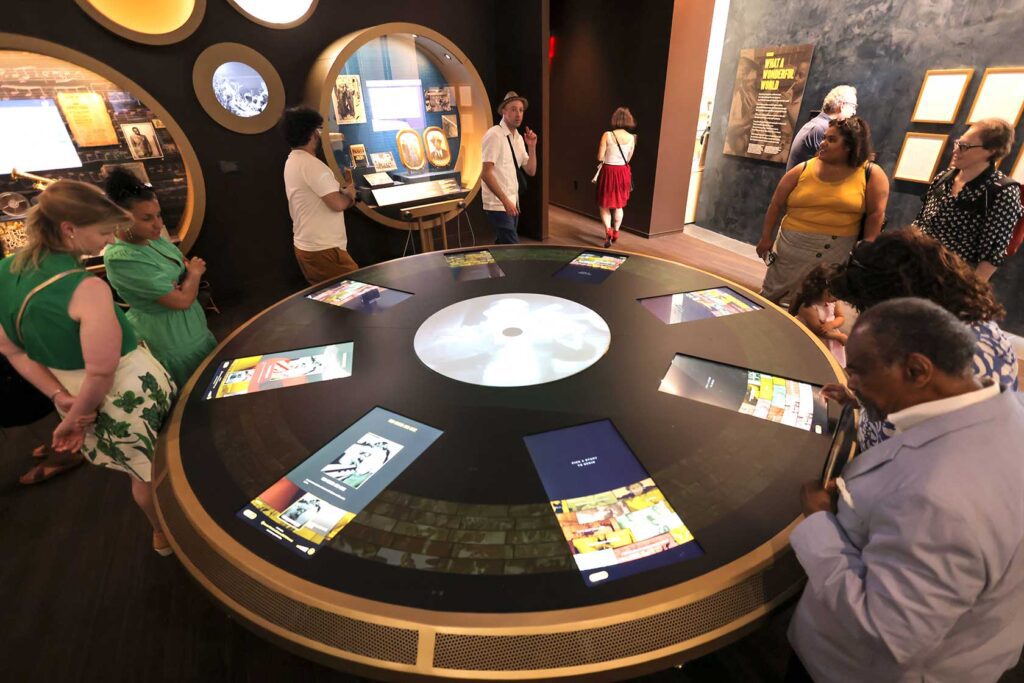Jason Moran curates multimedia exhibit on life of Louis Armstrong
Historic personal archives provide extensive material for ‘Here to Stay’

Born and raised poor in New Orleans at the start of the 20th century, Louis Armstrong (1901-1971) became one of America’s most influential and esteemed musicians, and with supreme congeniality and talent brought this country’s gift to the world — jazz — into a new level of artistry and global prominence.
A Black man who thrived both on stage and in his community, Armstrong left a rich legacy with his music and in the home he shared with his wife Lucille in the Corona neighborhood of Queens. The Louis Armstrong House Museum is a pilgrimage site for fans who may know Armstrong through his pop hits and for musicians who prize his innovations with trumpet, cornet and vocals. Now the newly opened Louis Armstrong Center, across the street from the Armstrongs’ brick house, enables visitors to explore Armstrong’s life and career through an interactive, multimedia exhibition entitled “Here to Stay.”
Jazz musician Jason Moran is the exhibition’s curator. “Each of us has our version of Louis Armstrong — what he looks like, what he means to us,” Moran said as he began an illustrated talk last Thursday night at the Museum of Fine Arts, Boston about his three-year immersion in the Armstrong collections while curating “Here to Stay.”

Detail from the exhibit “Here to Stay” at The Louis Armstrong Center in Queens, NY. PHOTO: ANDREW KELLY/BOWERY IMAGE GROUP
Moran, artistic director for jazz at Washington, D.C.’s Kennedy Center and a New England Conservatory professor, is also a visual artist. His multimedia projects often showcase overlooked Black musicians and storied places in the history of jazz. His 2018 show at the Institute of Contemporary Art, Boston reproduced such hallowed landmarks as the gilded stage of the Savoy Ballroom. He and his ensemble recently recorded and performed a musical tribute to James Reese Europe (1881–1919), whose 369th Infantry Jazz Band brought the sound of syncopation overseas during World War I, an achievement Moran describes as “one of the seminal Big Bangs in Black music.”
At the MFA last week, projecting images and occasionally playing the piano as he reflected on creating the exhibition, Moran said, “I could have had no better guide through the pandemic than Louis Armstrong.”

The Louis Armstrong Center in Queens, New York, opens with a multimedia exhibition, “Here to Stay,” curated by Jason Moran. PHOTO: ANDREW KELLY/BOWERY IMAGE GROUP
In 1941, Lucille Armstrong surprised her husband with the news of her down payment on their house. “He was performing 300 concerts a year,” said Moran. “This was their haven to entertain and relax. They were here to stay.” Of their chosen borough, Moran said, “Queens was the home of James Brown, Fats Waller, Billie Holiday and the founders of hip-hop. Music is in the ground here.”
Moran discovered that Armstrong had crafted more than 500 hand-decorated boxes to hold his carefully maintained collections of correspondence, photographs and memorabilia — compiling a record of his life and times, and, said Moran, “of all the people he and Lucille cherished.”
Moran drew from the 60,000-piece Armstrong archives, which are digitized and accessible online, to curate “Here to Stay.” The exhibition is organized by theme: Armstrong’s formative years; instruments; worldwide travels; on-screen performances; and hand-made artworks. Each segment is designed to invite further self-guided exploration.
“I can’t get over how much he left for us,” said Moran, who concluded by performing one of Armstrong’s many versions of “What A Wonderful World.” Playing the composition at home during the pandemic, said Moran, “brought into the darkness a bit of light.” And on this evening, Moran’s tender, minor-key rendering lingered long after its final note.







